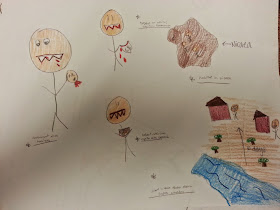I'm really sorry that I haven't been updating as often. Miriam and I both have taken on a lot this semester--in addition to creating entirely new curricula for our classes (untextbooking and Miriam's 80/20 Google classroom approach), we both teach online part-time and are enrolled in graduate school full-time. We've also been working on an online Latin curriculum for a local online high school. It has been a very busy semester. If you add to that the new house I just bought (and spent the weekend refinishing floors for), I have a lot on my plate and just haven't had time to write a blog post.
However, here is one for a unit that I and my students have really enjoyed. It's been vocabulary-intensive, but fun, and has triple repetition built in to just the readings, so if you add to that a question and answer or storytelling approach, the unit really builds up that vocabulary that it uses.
Without further ado, here is a link to the unit itself, and I'll explain the various pieces below.
Pliny Unit Of Monsters and Men
The first things listed on the unit I linked are there for the teacher's use. They are the original Pliny with my (quick and possibly somewhat inaccurate) literal translations. From there, I created an embedded form that mostly focused on changing the word order into something more comprehensible to my Latin II students, but generally does not change either vocabulary or grammatical forms. Finally, I created what I called pre-readings with lists of vocabulary and very repetitive and expanded readings based on the embedded version of the Latin.

You can scroll down the linked document to find the format of the handouts I gave my students; we began with four days of vocabulary via TPRS and follow-up readings with a lot of question and answer. After those four days, we read all of the four pre-readings as a unit and I assigned students the following:
The goal was some great synthesis of the information and a chance to play with Pliny's format and his means of authenticating his materials.
I had some wonderful student work as the result of the assignment. I'd love to post it all here, but here are some examples:
 |
| Homines Cani--The gray-headed, gray-eyed people from Albania. |
 |
| Homines Pedibus Aversis--Super fast men with backwards feet. |
 |
| Anthropophagi--Cannibals who drink from human skulls. |
 |
| One of the most beautifully illustrated original races students created. |
 |
| All of the Plinian races plus the original race on one page. |
Following this I posted some of the student work on the board and asked questions that highlighted the upcoming vocabulary and a grammatical form I was slightly concerned about. Then we read the embedded version of the section, and followed that with the original Pliny. Again, repetition and question and answer were very important in this section.
Lastly, because we had approximately two state-testing-free days left before I needed to do my last test before finals (so much testing at the end of the year--I am timing that test around state tests and AP tests), I added Pliny's description of a unicorn (with elephant feet!) and followed pretty much the same process.
The test will include general comprehension questions for the sections of Pliny, as well as some recognition questions including the grammar (contextual understanding of the vocabulary).
This has been a really fun unit for myself and my students. We analyzed why the Romans could believe in such things, what kind of sources Pliny might have been referencing, the motivations for various parts of the descriptions, and the background of Pliny himself. I got to teach material that inspires me. It has been a really great experience, and I found a new way to present material to help it make sense to my students.
No comments:
Post a Comment